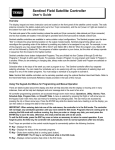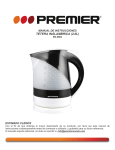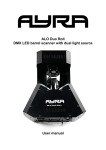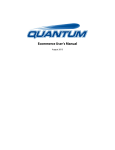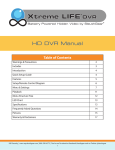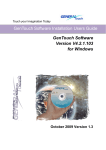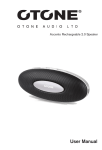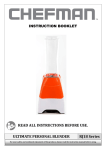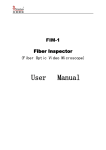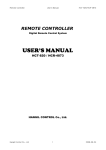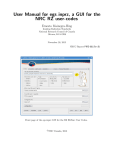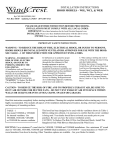Transcript
AVCS RATE GYRO FOR MODELS KM-401 Do not operate the rudder trimmer while flying in the AVCS mode. When the power is turned on, the KM-401 assumes that the rudder stick is in the neutral position. If the rudder trimmer is moved during flight, the neutral position will change. Avoid sudden temperature changes. USER MANUAL http://www.rckingmax.com Sudden temperature changes will cause the neutral position to change. For instance, do not fly the model immediately after removing it from inside a heated vehicle in the winter and an air conditioned vehicle in the summer. Let the model stand for about 10 minutes to allow the temperature inside the gyro to stabilize before turning on the power. Also, consider sudden temperature changes when the gyro is exposed to direct sunlight or is installed near the engine. Take measures so that the gyro is not exposed to direct sunlight. When using the gyro in the AVCS mode, set revolution mixing to 0% or OFF. In the AVCS mode, all rudder corrections are made by the KM-401. Therefore, if rudder mixing is ON, the model will operate the same as if the neutral position changed. Check the operating time of the receiver, gyro, and servo batteries at the adjustment stage and decide the number of remaining flights while allowing a margin. When the power was turned on (neutral position memorized in the gyro). When flying in the AVCS mode, set the rudder trim to the same position under all flight conditions, including hovering and idle up. In the AVCS mode, the gyro automatically trims the rudder so that trimming during flight and other precision rudder trim adjustments are unnecessary. OTHER PRECAUTIONS When using servos that are not compatible with high-speed pulse drive, other than digital servos, never set the DS switch to ON. The servo may be destroyed. When the model is static, the servos may move a small step. However, this is because the gyro sensitivity is set to a high value and is normal. Relationship between servo horn length and gyro sensitivity Gyro sensitivity also changes with the length of the servo horn. When the sensitivity is too low, length the servo horn. Conversely, when hunting does not stop, shorten the servo horn. FOREWORD KM-401The lightest gyro in the world. It is a high performance, compact, light weight AVCS (Angular Vector Control System) gyro developed for smaller than 500 electric model helicopters. Because the sensor and control circuit are integrated, it is simple to install. Gyro performance largely depends on the servo used. The higher the speed and response of the servo, the better the gyro sensitivity and performance. From this standpoint, a digital servo is perfect for use with this gyro. The KING MAX high-speed digital servos developed especially for gyro use is recommended. Also, the Futaba high-speed digital servos can work very well wih this gyro. SAFETY WARNINGS AND PRECAUTIONS FEATURES •AVCS system Since rudder trim changes caused by wind and other meteorological changes and front, rear, forward, reverse, and other helicopter attitude changes are automatically cancelled, tail (rudder) operation is easy, making it perfect for 3D flight. •Piezo gyro sensor Thank you for buying a KM-401 AVCS gyro. Before using this product, please read the user manual thoroughly and use the product properly and safely. Use of newly developed extremely low drift HH-Piezo sensor gyro sensor virtually eliminates rudder trim changes during flight. •Digital servo compatible (DS mode) ! IMPROTANT SAFETY INSTRUCTIONS! ! DS mode makes it compatible with Futaba digital servos. Maximizes the high-speed response performance of the digital servo. READ ALL INSTRUCTIONS BEFORE USING THIS PRODCUT! •Remote gain function and mode switching function MOUNTING PRECAUTIONS Remote gain function allows sensitivity switching from the transmitter and mode switching function allows AVCS/normal gyro mode switching. Always use the double-sided sponge tape to install the gyro to the fuselage. This is necessary to securely fasten the gyro to the fuselage so that operation of the gyro does not transmit unwanted fuselage vibrations directly to the sensor. When mounting the gyro, provide a little surplus so that the gyro connection cables are not too taut. If the gyro cables are too taut, the gyro will not display its full performance. If the gyro peels, control will be lost and result in a dangerous situation. When using the gyro with a helicopter, install the KM-401 at least 10cm from the drive motor. The drive motor generates strong electromagnetic noise. This noise may interfere with the gyro sensor and cause erroneous operation. Mount the KM-401 so that metals or other conductive objects do not touch the gyro case. The KM-401 uses a conductive resin case to reduce electromagnetic interference. Because the surface of the case is conductive, metal objects may cause a short circuit. Insert the connectors fully. If a connector works loose due to vibration during flight, control may be lost and result in a dangerous situation. Always check the direction of operation of the servos. If you attempt to fly the model when a servo operates in the wrong direction, the fuselage will spin in a fixed direction and enter an extremely dangerous state. OPERATION PRECAUTIONS Never move the fuselage for about 3 seconds after turning on the gyro power (shared with receiver). Since the data inside the gyro is automatically initialized as soon as the power is turned on, if the fuselage is moved, the neutral position will change. If this occurs, turn the power off and on again. When turning on the power, set the transmitter switch to the AVCS position and turn on the transmitter power switch, then turn on the gyro power. KM-401 Ratings: (Integrated sensor type AVCS rate gyro) •Control system: Digital advanced PI (Proportional Integration) control •Gyro sensor: HH-Piezo gyro system vibration gyro •Operating voltage: +4.5 to +6VDC •Operation Current: 50 mA (at 4.8V) •Operating temperature range: -5˚C to +60˚C •Dimensions: 30 x 18 x 8mm •Weight: 6.5g (including connector) •Functions: Gyro operation direction switch, DS mode switch, Remote gain control, AVCS/normal mode switching PAGE 1 OF 4 KM-401 FUCTIONS PAGE 2 OF 4 RUDDER SERVO LINKAGE CHECK DS Mode Switch (DS) Set the transmitter gyro sensitivity switch to the AVCS position and turn on the transmitter power, then turn on the gyro power (shared with receiver). Since the KM-401 initializes the data when the power is turned on, set the rudder stick to the neutral position and do not move the helicopter for approximately 3 seconds. If the monitor LED is red light, the gyro is operating in the AVCS mode. When the power is turned on in the normal mode, the monitor will display green light. Set the sensitivity,switch to the AVCS position and turn on the gyro power again. Next, switch the transmitter switch to the normal gyro mode position and check the linkage. Digital servo (DS) mode switch. The ON position is the high-speed output mode for digital servo only. When using a normal servo, always set this switch to the OFF position. If it is set to the ON position, the servo will be destroyed. Rudder Servo Connector Connects the rudder servo. Rudder Input Connector - In the rudder neutral position, connect the linkage so that the servo horn and control wire are perpendicular. Set the servo horn length based on the model manufacturer's instructions. Connects to the receiver rudder channel (CH4) output connector. Sensitivity Switching Connector Gyro sensitivity switching signal input connector. Connect to the receiver sensitivity switching channel (normally CH5). This connector is also simultaneously used to switch between the AVCS and normal operation modes. Since this connector is a single wire signal line, do not pull it forcefully. Monitor LED Indicates the operating status of the KM-401. The display contents are shown below. Perpendicular Tail control wire - Move the rudder stick to the left and right.If the servo operating angle strike the linkage, reinstall the linkage to a closer hole on the servo arm untill the servo operating angle dose not strike the linkage. Gyro Operation Direction Switch (DIR) Switches the gyro control direction. It must be switched according to the direction of rotation of the main rotor and the direction of the rudder linkage. If the rudder servo moves in the cancellation direction when the nose of the helicopter moves, the operating directions are good. If you try to fly a model with a clockwise rotation rotor when the gyro operation direction is reversed, the nose will turn to the left and result in a dangerous situation. ATTN: If the setting is too low, the gyro performance will be affected. Tail control wire MONITOR LED DISPLAY LED DISPLAY GYRO OPERATION STATE Rapid flash Displayed while data is being initialized at power ON. Steady red light Indicates that the gyro is operating in the AVCS mode. - Move the rudder stick to the left and right, and check the direction of operation of the tail rotor. If the tail rotor rotates in the wrong direction, adjust the direction with the transmitter reverse function. Indicates that the power is OFF. GYRO SENSITIVITY SETTING CRITERIA Off Slow flash Steady green light Displayed when there are no rudder operation signal being input from the transmitter. At this time, the rudder servo does not operate. Indicates that the gyro is operating in the Normal mode. INSTALL THE KM-401 TO FUSELAGE GYRO INSTALLATION KM-401 900 Install the gyro so that the bottom of the gyro is perpendicular to the direction of the main rotor shaft axis. Changes of this axis are also reflected in the roll and pitch directions. GYRO OPERATION DIRECTION CHECK If the rudder servo moves to the left when the nose of the helicopter moves to the right, the gyro direction is correct. If the rudder servo operates in the reverse direction, switch the switch. REV RUDDER NEUTRAL POSITION ADJUSTMENT •When making your first flight and when reconnecting the linkage, set the mechanical rudder neutral position by first flying in the normal mode and then flying in the AVCS mode. •After completes mechanical neutral position adjustment. Land the helicopter and set the gyro to the AVCS mode. When flying, the power must always be turnedon in the AVCS mode and the rudder neutral position read each time. Always install the KM-401 using the double-sided sponge tape. When using the KM-401 with a motor helicopter, install the gyro at least 10cm from the drive motor. The gyro sensitivity differs with the servos used and the fuselage. Generally, the faster the servo operating speed, the higher the gyro sensitivity. Also, when the main rotor speed is raised, the tail sensitivity of the helicopter itself rises and the gyro sensitivity at idle up must be dropped below the sensitivity when hovering. Start sensitivity adjustment with a gyro sensitivity for a small electric model helicopter of 60 ~ 70% when hovering and 50 ~ 60% during flight as the criteria and search for the best sensitivity for the helicopter used. Zoom In PAGE 3 OF 4 PAGE 4 OF 4

